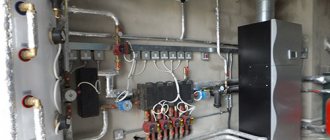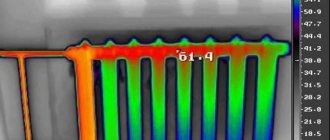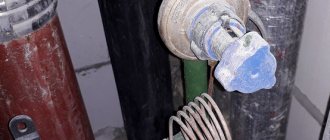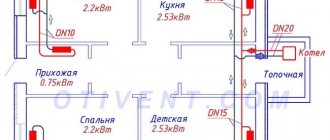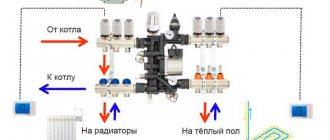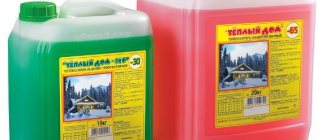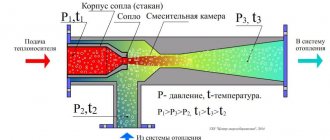Types and features
To heat country houses and dachas, an autonomous heating system is installed. It consists of a heating boiler connected to heating radiators by an extensive piping system. The non-freezing liquid poured into them acts as a coolant. After heating in the boiler, it flows through pipes to the radiators.
Non-freezing liquid is commonly called antifreeze. Their chemical composition does not allow them to freeze even in the most severe frosts. Antifreeze prevents corrosion on the inner surface of pipes and radiators and does not form scale on it. The choice of the type of coolant to be poured into the heating system depends on various factors, including the climatic conditions of the region of its use.
In addition to antifreeze, which acts as a coolant, the operating rules of the heating system require its periodic flushing with special liquids. Their composition contains various additives.
An alternative to such flushing liquids is an aqueous solution of caustic soda. Fill the system with it for 1-1.5 hours. This is done to dissolve the scale accumulated on the internal surfaces of the heating system elements with a soda solution.
Antifreezes with different characteristics can be found on sale. The following can be used as their basis:
Glycerol
Ethylene glycol
Propylene glycol
All these substances have a high degree of aggressiveness, so manufacturers add various additives to their composition. The main component of antifreeze determines its properties. Antifreeze liquids based on ethylene glycol are the most affordable, but they are also the most toxic.
Antifreeze liquids based on ethylene glycol cannot be used for double-circuit boilers. If such antifreeze enters the water supply system, it can cause severe poisoning. The liquid boils at temperatures above 110°C and may produce sediment. It often causes the heating system to fail.
Antifreezes based on propylene glycol are less dangerous and harmful to the human body. Non-freezing liquids made on the basis of glycerin are environmentally safe.
Antifreezes of this type protect the heating system well from corrosion. A feature of glycerin antifreeze liquids is that when they transition to a solid state, they do not increase in volume.
The lowest freezing point and the highest boiling point, as well as the heat transfer capacity of the bischofite solution. Very often, solutions of calcium, sodium and other mineral salts are used as a coolant in heating systems. Their advantage is considered to be high corrosive aggressiveness.
Why should you NOT use a GLYCERINE mixture - antifreeze - in the heating system??
Let's look at specific examples of what is best to fill into the installed heating system in your home or into the air conditioning and ventilation system, for example, of a shopping complex.
In order for these systems to operate flawlessly at any time of the year, it is necessary to use coolants that would not only provide heating of the room, but also have properties such as a low freezing point, because frosts in Russia have not yet been canceled. When choosing a coolant, you must also not forget about such indicators as high thermal conductivity and heat capacity, protection against corrosion of all construction materials, the ability to work without scale formation, inertness in relation to sealing materials, and finally, stability and long service life during the operation of your heating system. What is best to pour into the heating system depends on the specific operating conditions, your boiler equipment, heat exchangers, pumping equipment, etc.
For any heating system, water or a special low-freezing liquid - coolant (household antifreeze) can be used as a coolant.
Water is the cheapest, most accessible and environmentally safe coolant, but it also has a number of disadvantages, since a heating system that operates on water must constantly be in a state of heating in the positive temperature zone so as not to defrost the system. The chemical composition of water contains many different impurities of iron, chlorine, salts, and therefore, when heated, these impurities are deposited on the walls of pipes, on the surfaces of heat exchangers, heating elements, which causes a deterioration in heat transfer, and the heating elements may fail due to overheating .
And one more important argument: in the event of an emergency shutdown of electricity or gas in the autumn-winter period, the system must be drained to prevent it from defrosting.
Criterias of choice
A factor common to all coolants that influences the choice of products is its environmental safety. Human health and comfort in the home depend on the quality and type of coolant poured into the heating system.
First of all, the choice of liquid depends on the design of the heating system. It is important what material it is made of. Important factors for choosing a coolant are the power of the pumps and radiators involved in the heating system, as well as the type of heating boiler.
When buying liquid for the first time, it is better to seek advice from specialists. This will allow you to get professional advice and avoid failure of the heating system of a country house. According to experts, in heating systems of country houses it is better to use liquids with a freezing point of -20-25°C.
Expert opinion
Torsunov Pavel Maksimovich
It is undesirable to use water as a coolant due to its ability to cause corrosion and form scale on the inner surface of heating system elements.
When water freezes, it noticeably increases in volume, which, if an emergency occurs during the cold season, can lead to rupture of pipes and radiators. The use of antifreeze completely eliminates this possibility. It is important that its composition is of high quality and reliable.
Each heating system has its own operating characteristics. Some of them must be taken into account when choosing the type of coolant. Among them are the minimum ambient temperature and the maximum temperature of the coolant during heating. Both of these indicators are borderline when the liquid transitions to another physical state.
Many manufacturers produce heating boilers in which the use of non-freezing liquids is strictly prohibited.
After determining the performance characteristics of the coolant, be sure to pay attention to its manufacturer and cost. For residential premises, it is extremely important to fill the heating system with environmentally friendly liquid. Coolants with expired service life can become mortally dangerous to humans.
An important criterion for choosing a liquid is its chemical composition and the type of additives added to it. The latter have direct attention to the possible lifespan of the coolant in the system. You can work the longest with organic antifreeze.
Benefits of propylene glycol for heating
This point and the one described above answer the question of why it is recommended to choose propylene glycol as the coolant for heating systems in a country house. This additive in many types of coolants has more than one advantage:
- Propylene glycol dissolves instantly in water and mixes well with other types of substances.
- Makes the freezing point of the original substance much lower.
- Absorbs moisture well from the surface and atmosphere.
As mentioned above, it crystallizes only at very low degrees, is fireproof and does not emit toxic substances. Propylene glycol is not harmful to the human body and is easily decomposed. The solution without impurities is widely used in the cosmetology industry, food industry and pharmaceuticals.
What volume should be filled?
The amount of liquid poured into the heating system depends on various factors. The main ones are:
- heating boiler volume;
- type of heating system;
- quality of materials for manufacturing pipes and radiators;
- area of the heated room.
Calculation of the volume of liquid for filling the system is carried out based on the recommendations of the manufacturers. The boiler technical data sheet contains information about what coolant can be used and in what volume.
Coolant rating
What do you use in your heating system?
AntifreezeWater
The liquid poured into the heating system must meet a number of mandatory requirements. These include:
- high degree of heat capacity (the liquid must accumulate maximum heat and transfer thermal energy with minimal losses);
- gentle, stable composition (the liquid should not cause corrosion of the internal surfaces of heating equipment and contain mineral salts capable of forming scale);
- wide range of operating temperatures (the coolant must have a large “fork” between boiling and freezing temperatures).
Important indicators for a non-freezing liquid are density, viscosity and chemical inertness. All liquids must be completely safe for human health. Based on the totality of all indicators, several groups of the best coolants can be distinguished.
Propylene glycol based
Antifreezes of this group are recommended for use in heating systems of food production, children's and medical institutions. They are universal in use, have excellent physical and chemical properties and are environmentally safe. The most popular coolant of this type is “Warm House EKO30”.
The liquid contains additives that protect the internal surfaces of the heating system elements from corrosion and prevent the formation of scale. Before pouring into the system, the liquid is diluted with distilled water.
Improper dilution of antifreeze with other liquids can lead to decomposition of the additives in it. The main purpose of the coolant is to be poured into heating systems with galvanized pipes. The liquid does not form foam.
Characteristics:
- operating temperature range – from -30 to +106°С;
- service life – up to 5 years;
Advantages:
- absolute safety for people and animals;
- explosion and fire safety.
Flaws:
- cannot be used in heating systems with electrode boilers;
- Can only be used for one operating temperature.
Ethylene glycol based
Antifreezes of this group have restrictions on their use. It is used in heating systems of buildings isolated from human activity. The most popular coolant of this type is “DIXIS-65”. Antifreeze can reduce the intensity
corrosion of internal surfaces of heating system elements, does not form foam.
It is equally compatible with various metals and polymers. Due to its low freezing point, it is recommended for use in areas with harsh winters. When pouring antifreeze into the heating system, it can be diluted with water, but its amount should not exceed 30% of the total volume of liquid.
Characteristics:
- operating temperature range – from -65 to +111°С;
- service life – up to 5 years;
Advantages:
- high quality;
- long service life.
Main disadvantage:
- It is not recommended for use in heating systems that heat residential premises.
Ethylene glycol or propylene glycol. What's better?
Both ethylene glycol and propylene glycol have the necessary characteristics for use in heating systems requiring frost protection. Namely: high boiling point, low freezing point, stability under temperature changes, high thermal conductivity coefficient. In addition, when used with appropriate inhibitors, glycol antifreezes provide good corrosion resistance, which helps extend the life of the entire system.
Please note that antifreezes used in the automotive industry are absolutely not suitable for heating systems in homes! Do not use them under any circumstances!
Ethylene glycol-based solutions work well as antifreeze for heating due to their excellent heat transfer properties. However, they have one significant drawback - ethylene glycol is toxic when exposed orally, that is, if swallowed. Therefore, we recommend considering propylene glycol-based coolants for use in residential buildings.
A solution of propylene glycol with anti-corrosion additives (inhibitors) is recommended for use as antifreeze in systems where accidental contact with drinking water is possible. But still, although propylene glycol is considered a non-toxic substance, of course, you should not eat it.
Questions and answers
Can all heating systems be filled with antifreeze?
It is not recommended to use antifreeze in open heating systems with natural circulation.
When can water be added to the heating system and when can antifreeze be added?
If the house is constantly heated and there is no threat of an emergency heating stop, then the system can be filled with distilled water. In other cases, only non-freezing liquid is poured. When releasing it, they are guided by the range of operating temperatures of the liquid and the technical characteristics of the heating system.
Is it possible to mix different antifreeze liquids?
It is strictly not recommended to mix coolants without checking compatibility. An unsuccessful composition can destroy the heating system and damage the heating boiler.
What kind of water can be used to dilute coolants?
Before pouring into the heating system, antifreeze is diluted with distilled water. This liquid is cleared of foreign impurities and desalted. In all other cases, scale will form on the inner walls of the heating system elements. Its quantity depends on the water hardness index.

